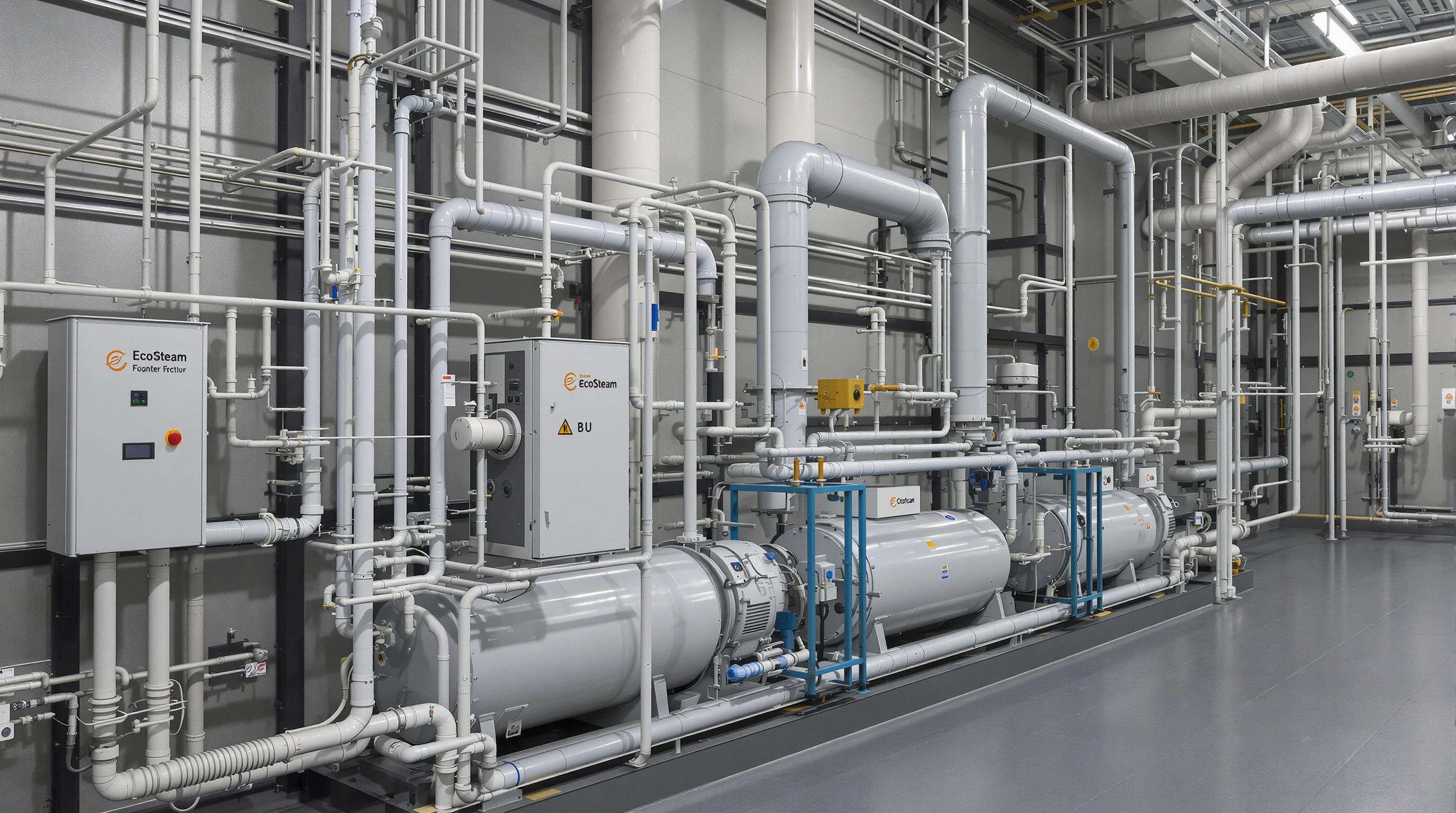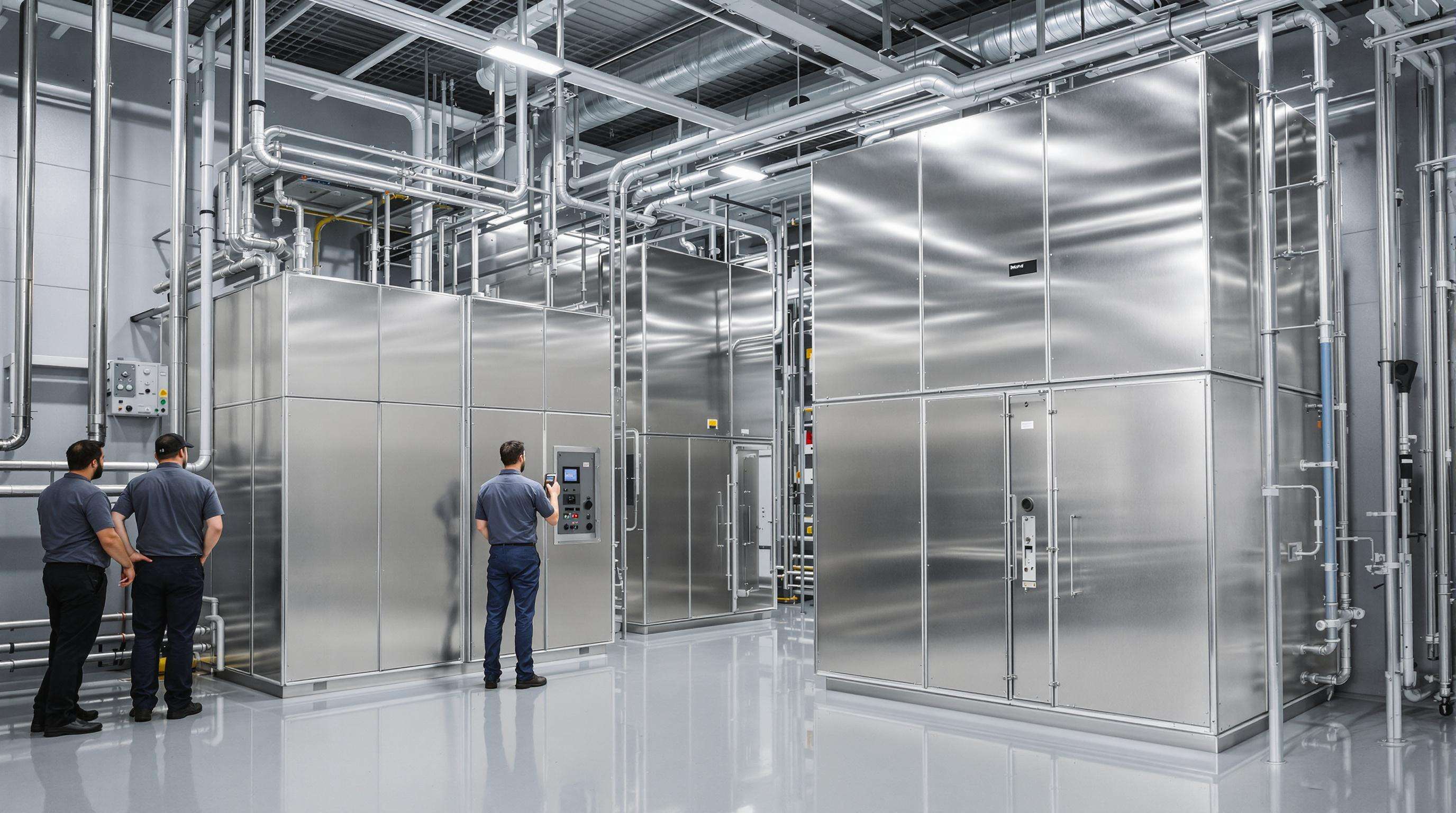ประโยชน์ในการเลือกซื้อเครื่องกำเนิดไอน้ำบริสุทธิ์แบบส่งตรงจากโรงงานผลิต EcoSteam
การประยุกต์ใช้เครื่องกำเนิดไอน้ำบริสุทธิ์ในอุตสาหกรรมที่มีการควบคุม
บทบาทของไอน้ำบริสุทธิ์ในกระบวนการฆ่าเชื้อและทำให้ปราศจากเชื้อ
เครื่องกำเนิดไอน้ำบริสุทธิ์มีบทบาทสำคัญในการรับประกันการฆ่าเชื้ออย่างเหมาะสมภายในสภาพแวดล้อมที่ถูกควบคุม ไอน้ำอุตสาหกรรมทั่วไปมักมีส่วนผสมและสารเคมีตกค้าง ในขณะที่ไอน้ำบริสุทธิ์ปราศจากสารปนเปื้อน ซึ่งทำให้มันเหมาะสำหรับงานสำคัญๆ เช่น กระบวนการฆ่าเชื้อด้วยเครื่อง Autoclave และการควบคุมระดับความชื้นในห้องสะอาด เมื่อสถานที่ดำเนินการใช้ระบบไอน้ำบริสุทธิ์ที่ได้รับการตรวจสอบและรับรองอย่างเหมาะสม พวกเขาสามารถคาดหวังการลดจำนวนจุลินทรีย์ลงได้ประมาณ 99.99% และลดความเสี่ยงจากสารพิษที่เกิดจากตัวเลือกไอน้ำมาตรฐานได้อย่างมาก ห้องปฏิบัติการและโรงงานผลิตหลายแห่งต่างรายงานถึงการปรับปรุงระดับการรับประกันความปราศจากเชื้อได้อย่างชัดเจน หลังจากเปลี่ยนมาใช้ระบบพิเศษเหล่านี้
กรณีการใช้งานไอน้ำความบริสุทธิ์สูงในอุตสาหกรรมยาและชีวเทคโนโลยี
ในกระบวนการผลิตทางชีวเภสัชกรรม ไอน้ำบริสุทธิ์มีบทบาทสนับสนุนกระบวนการทำให้ปราศจากเชื้อในขั้นตอนสำคัญต่าง ๆ ได้แก่ การทำให้เครื่องปฏิกิริยาชีวภาพปราศจากเชื้อ การล้างหลอดทดลอง และระบบทำความสะอาดอุปกรณ์ในที่ (CIP) ความจุที่ต้องการมีความแตกต่างกันไปตามขนาดและลักษณะการใช้งาน:
| ระดับความจุ | Applications | ข้อกำหนดด้านความสอดคล้อง |
|---|---|---|
| ขนาดเล็ก (≤500 กก./ชม.) | การทำให้อุปกรณ์ห้องปฏิบัติการปราศจากเชื้อ งานวิจัยและพัฒนา | ISO 9001, cGMP |
| ขนาดกลาง (501–2000 กก./ชม.) | ถังหมักขนาดผลิตจริง สายการบรรจุ | EU Annex 1, FDA 21 CFR Part 211 |
| ขนาดใหญ่ (>2000 กก./ชม.) | ระบบปรับอากาศแบบรวมทั้งโรงงาน การสังเคราะห์สาร API เป็นจำนวนมาก | PIC/S, มาตรฐาน GMP ขององค์การอนามัยโลก |
ความสอดคล้องตามมาตรฐานสากล (เช่น ฟาร์มาโคปียุโรป, ISO 13485)
อุตสาหกรรมที่อยู่ภายใต้การควบคุมจำเป็นต้องปฏิบัติตามมาตรฐานฟาร์มาโคปี อย่างเช่น USP <1231> และ Ph. Eur. 5.1.9 เป็นส่วนหนึ่งของการดำเนินงานของตน สำหรับระบบไอน้ำบริสุทธิ์ การลดระดับก๊าซที่ไม่ควบแน่นให้ต่ำกว่า 0.1 ppm และควบคุมจำนวนจุลินทรีย์ให้อยู่ต่ำกว่า 0.2 CFU/mL มีความสำคัญมากเมื่อเผชิญกับการตรวจสอบทั่วโลก ข่าวดีคือ การตรวจสอบและรับรองแบบอัตโนมัติได้ทำให้สิ่งต่างๆ ง่ายขึ้นมากสำหรับทีมงานที่ทำหน้าที่ปฏิบัติตามข้อกำหนด บริษัทต่างๆ รายงานว่าสามารถลดต้นทุนได้ประมาณ 60% เมื่อเทียบกับวิธีการแบบเดิมที่เป็น manual แม้ว่าผลลัพธ์อาจแตกต่างกันไปขึ้นอยู่กับขนาดและความซับซ้อนของสถานประกอบการ PDA Technical Report 82 สนับสนุนข้อมูลเหล่านี้ โดยแสดงให้เห็นว่าการใช้ระบบอัตโนมัติช่วยทำให้กระบวนการที่เคยใช้เวลานานนั้นรวดเร็วขึ้น
กรณีศึกษา: การเพิ่มประสิทธิภาพการผลิตเภสัชภัณฑ์ชีวภาพด้วย EcoSteam
ผู้ผลิตวัคซีนชั้นนำรายหนึ่งลดการเกิดข้อผิดพลาดของแบตช์ได้ลง 42% หลังจากเปลี่ยนเครื่องไอน้ำที่ล้าสมัยเป็นเทคโนโลยีไอน้ำบริสุทธิ์แบบโมดูลาร์ ระบบใหม่นี้มีการตรวจสอบ TOC แบบเรียลไทม์และดีไซน์แนวตั้งที่ช่วยให้วัฏจักรการฆ่าเชื้อในที่ (SIP) เร็วขึ้น 30% ขณะยังคงความสอดคล้องตามมาตรฐานห้องสะอาด ISO 14644-1 Class 5
ประสิทธิภาพพลังงานและการออกแบบที่ยั่งยืนของเครื่องกำเนิดไอน้ำอีโคสตีม

ระบบการกู้คืนความร้อนขั้นสูงสำหรับการใช้พลังงานที่ต่ำลง
เครื่องผลิตไอน้ำรุ่นล่าสุดแบบบริสุทธิ์มาพร้อมกับระบบการกู้คืนความร้อนที่ช่วยลดการใช้พลังงานลงได้ประมาณ 30% เมื่อเทียบกับรุ่นเก่า ระบบเหล่านี้ทำงานโดยการดักจับความร้อนที่เหลืออยู่จากกระบวนการควบแน่น และนำความร้อนนั้นไปใช้เพื่อทำให้แหล่งน้ำที่ไหลเข้ามามีอุณหภูมิสูงขึ้นก่อนที่จะเข้าสู่ระบบ ซึ่งหมายความว่าต้องใช้พลังงานจากภายนอกน้อยลงในการทำให้ระบบทำงานได้อย่างเหมาะสม เมื่อปีที่แล้วมีการเผยแพร่ผลการวิจัยที่ศึกษาประสิทธิภาพของระบบท่อน้ำร้อนในอุตสาหกรรมต่าง ๆ ซึ่งผลลัพธ์ที่ได้นั้นค่อนข้างน่าสนใจ โดยโรงงานที่ดำเนินการตามหลักการปฏิบัติที่ดีในการผลิต (GMP) พบว่าค่าใช้จ่ายในการดำเนินงานต่อปีลดลงระหว่าง 18 ถึง 24 ดอลลาร์ต่อตารางเมตร หลังจากนำวิธีการกู้คืนความร้อนที่มีประสิทธิภาพมากขึ้นมาใช้ การประหยัดเช่นนี้จึงมีความหมายสำหรับองค์กรที่พยายามปฏิบัติตามมาตรฐานพลังงานในปัจจุบัน พร้อมทั้งควบคุมค่าใช้จ่ายในการดำเนินงาน
การลดปริมาณก๊าซเรือนกระจกในโรงงานที่ปฏิบัติตามมาตรฐาน GMP และโรงงานอุตสาหกรรม
เมื่อพูดถึงการผลิตไอน้ำแบบบริสุทธิ์นั้น การนำแนวทางวิศวกรรมที่ยั่งยืนมาใช้สามารถช่วยลดการปล่อยก๊าซคาร์บอนได้ตั้งแต่ 15 ถึงแม้แต่ 25 เปอร์เซ็นต์ภายในสภาพแวดล้อม GMP การผสมผสานระบบไฟฟ้าเข้ากับแผงควบคุม IoT ที่ชาญฉลาดนั้น ช่วยให้สามารถควบคุมพลังงานได้อย่างมีประสิทธิภาพมากยิ่งขึ้น ในขณะที่ระบบคืนน้ำกลั่นสามารถกู้คืนน้ำที่ใช้ในการดำเนินงานได้ราว 95% การลดการใช้น้ำจืดลงนั้นชัดเจนว่าเป็นข้อได้เปรียบที่สำคัญ แต่ยังมีประโยชน์อีกอย่างหนึ่งคือ ระบบเหล่านี้ช่วยลดการปล่อยก๊าซ CO2 ที่เกี่ยวข้องกับการบำบัดน้ำเสียจำนวนมาก และสิ่งนี้มีความสำคัญมากขึ้นเรื่อยๆ เนื่องจากกฎระเบียบด้านสิ่งแวดล้อมมีแนวโน้มที่จะเข้มงวดมากยิ่งขึ้นในทุกด้าน
การประหยัดต้นทุนในระยะยาวผ่านวิศวกรรมที่ยั่งยืน
การลงทุนในเครื่องผลิตไอน้ำบริสุทธิ์ที่มีประสิทธิภาพในการใช้พลังงาน มักจะคืนทุนเต็มจำนวนภายใน 2â3 ปี เนื่องจากค่าสาธารณูปโภคและการบำรุงรักษาที่ลดลง ข้อมูลเปรียบเทียบแสดงให้เห็นถึงข้อดีดังนี้:
| เมตริก | เครื่องกำเนิดไฟฟ้าแบบปกติ | เครื่องผลิตไอน้ำ EcoSteam |
|---|---|---|
| ค่าพลังงานรายปี | $540,000 | $380,000 |
| ความถี่ในการบำรุงรักษา | 8â10 ครั้ง/ปี | 3–4 ครั้ง/ปี |
| การปล่อยก๊าซ CO₂ | 620 ตันเมตริก/ปี | 460 ตันเมตริก/ปี |
ประสิทธิภาพที่ได้รับนี้เกิดจากวัสดุที่มีความทนทาน เช่น โลหะผสมที่ต้านทานการกัดกร่อน และระบบอัตโนมัติสำหรับตรวจสอบตนเอง ซึ่งช่วยยืดอายุการใช้งานของอุปกรณ์ได้ยาวนานขึ้น 40–50% นอกจากนี้ การปฏิบัติตามนโยบายภาษีคาร์บอนที่เปลี่ยนแปลงอยู่ตลอดเวลา ยังช่วยป้องกันค่าปรับในอนาคตและเพิ่มผลตอบแทนจากการลงทุนในระยะยาว
ความน่าเชื่อถือในการดำเนินงานและประสิทธิภาพการบำรุงรักษาต่ำ
คุณสมบัติการออกแบบที่เพิ่มประสิทธิภาพการใช้งานและความมีประสิทธิผลของระบบ
เครื่องผลิตไอน้ำบริสุทธิ์รุ่นใหม่ล่าสุดมีความสามารถในการบำรุงรักษาเชิงพยากรณ์ด้วยระบบอัตโนมัติและการตรวจสอบค่าความดัน อุณหภูมิ และการนำไฟฟ้าแบบเรียลไทม์ การแจ้งเตือนล่วงหน้าช่วยให้สามารถแก้ไขปัญหาได้ก่อนที่จะส่งผลกระทบต่อการทำงาน รอบการล้างคราบตะกรันอัตโนมัติช่วยลดการสะสมของแร่ธาตุลงได้ถึง 67% เมื่อเทียบกับการทำความสะอาดแบบแมนนวล ช่วยให้คุณภาพของไอน้ำคงที่และยืดอายุการใช้งานของชิ้นส่วน
ความทนทานและการหยุดทำงานลดลงของหน่วย EcoSteam
หน่วย EcoSteam ทำจากสแตนเลสและเคลือบด้วยสารที่ต้านทานการกัดกร่อน จึงสามารถทำงานต่อเนื่องได้แม้ในสภาพแวดล้อมที่มีความชื้นและอุณหภูมิสูงระดับสุดขั้ว การทดสอบในสภาพแวดล้อมจริงพบว่าระบบนี้โดยทั่วไปสามารถทำงานได้ประมาณปีละ 12,000 ชั่วโมง ซึ่งหมายความว่าชิ้นส่วนต่างๆ จำเป็นต้องเปลี่ยนบ่อยน้อยลงประมาณ 40 เปอร์เซ็นต์เมื่อเทียบกับค่าเฉลี่ยของผู้ผลิตทั่วๆ ไป นอกจากนี้ การออกแบบแบบโมดูลาร์ยังถือเป็นข้อได้เปรียบใหญ่โต เนื่องจากช่างเทคนิคสามารถเปลี่ยนชิ้นส่วนสำคัญ เช่น ตัวแลกเปลี่ยนความร้อน ได้ภายในเวลาไม่ถึงสองชั่วโมง สิ่งนี้ช่วยลดเวลาในการบำรุงรักษาลงไปได้ราวสามในสี่ ส่งผลให้ผู้จัดการโรงงานรู้สึกพึงพอใจมากขึ้นในช่วงเวลาผลิตที่ต้องแข่งกับนาฬิกา
โครงสร้างพื้นฐานด้านการสนับสนุนและการบริการเพื่อการดำเนินงานอย่างต่อเนื่อง
ผู้ผลิตชั้นนำมีบริการวินิจฉัยปัญหาจากระยะไกล และแผนบริการแบบมีลำดับชั้นที่ออกแบบมาเฉพาะสำหรับสถานที่ปฏิบัติการที่เป็นไปตามมาตรฐาน GMP กว่า 90% ของปัญหาในการดำเนินงานสามารถแก้ไขได้ผ่านระบบถ่ายทอดข้อมูลระยะไกลที่ปลอดภัย ในขณะที่ทีมงานประจำหน้างานมีความเชี่ยวชาญในการเข้าแก้ไขปัญหาอย่างรวดเร็วและเป็นไปตามข้อกำหนดขององค์การอาหารและยา (FDA) โมเดลการสนับสนุนแบบคู่นี้ช่วยให้การทำงานในกระบวนการสำคัญ เช่น การทำให้ปราศจากเชื้อและระบบล้างทำความสะอาด (CIP) เป็นไปอย่างต่อเนื่องไม่มีสะดุด
ความสามารถในการปรับแต่ง, การขยายระบบได้, และการผนวกรวมแบบโมดูลาร์

เครื่องผลิตไอน้ำแบบเพียวในปัจจุบันเป็นทางเลือกที่ยืดหยุ่นจริงๆ สำหรับโรงงานที่ต้องเผชิญกับพื้นที่จำกัด หรือความต้องการในการผลิตที่เปลี่ยนแปลงไป ด้วยการออกแบบที่เป็นแบบโมดูลาร์ ทำให้เครื่องเหล่านี้สามารถติดตั้งซ้อนกันได้ทั้งในแนวตั้งและแนวนอน ช่วยลดพื้นที่ใช้สอยบนพื้นโรงงานได้ประมาณ 40% ในขณะที่ยังคงระดับกำลังการผลิตเต็มรูปแบบไว้ได้ นอกจากนี้ โรงงานสามารถขยายกำลังการผลิตได้ทีละขั้น ตั้งแต่ประมาณ 100 กิโลกรัมต่อชั่วโมง ไปจนถึง 1,500 กิโลกรัมต่อชั่วโมงตามความต้องการ ซึ่งช่วยหลีกเลี่ยงค่าใช้จ่ายที่สูงในการปรับปรุงโครงสร้างพื้นฐานใหม่เมื่อกิจการเติบโต จุดที่ทำให้ระบบเหล่านี้โดดเด่นคือความสามารถในการปรับใช้ในอุตสาหกรรมที่หลากหลายแตกต่างกัน ทั้งระบบควบคุม วัสดุที่ใช้ และค่าความดันสามารถใช้งานได้ดีในหลายแอปพลิเคชัน เช่น บริษัทเภสัชกรรมใช้เครื่องเหล่านี้สำหรับการตรวจสอบความถูกต้องของเครื่องฆ่าเชื้อแบบอัตโนมัติ (Autoclave Validation) ขณะที่ผู้ผลิตอาหารใช้ในกระบวนการล้างอุปกรณ์ในที่เดิม (Cleaning-in-Place: CIP) ด้วยความหลากหลายในการใช้งานนี้ ทำให้หลายธุรกิจรายงานว่ามีค่าใช้จ่ายในการปรับปรุงระบบลดลง และติดตั้งได้เร็วขึ้น นั่นจึงเป็นเหตุผลที่ผู้ผลิตที่มีวิสัยทัศน์มองไปข้างหน้า มองว่าระบบไอน้ำแบบโมดูลาร์ไม่ใช่แค่เพียงเครื่องจักร แต่เป็นการลงทุนที่ชาญฉลาด เพื่อเตรียมความพร้อมสำหรับการเปลี่ยนแปลงที่จะเกิดขึ้นในอุตสาหกรรมของพวกเขา
การขยายการประยุกต์ใช้ตลาด beyond ยา
การใช้เครื่องผลิตไอน้ำบริสุทธิ์ในการผลิตอาหารและเครื่องดื่ม
ปัจจุบันบริษัทต่างๆ ในธุรกิจอาหารและเครื่องดื่มหันมาใช้ไอน้ำบริสุทธิ์เพื่อทำความสะอาดสายการผลิตและวัสดุบรรจุภัณฑ์มากขึ้นเรื่อยๆ เมื่อพูดถึงไอน้ำที่ปราศจากความชื้นและสารปนเปื้อน ไอน้ำนี้ช่วยให้เป็นไปตามกฎความปลอดภัยด้านอาหารที่เข้มงวดขององค์การอาหารและยาแห่งสหรัฐอเมริกา (FDA) และสหภาพยุโรป โดยเฉพาะอย่างยิ่งผลิตภัณฑ์นมและอาหารพร้อมรับประทานที่อาจเกิดการปนเปื้อนได้ง่ายจากความร้อน ข่าวดีก็คือวิธีการนี้ช่วยลดการใช้สารเคมีทำความสะอาดได้ค่อนข้างมาก โดยอิงจากผลการศึกษาล่าสุดพบว่าประมาณ 40% ด้วยเหตุนี้ ผู้แปรรูปจำนวนมากจึงหันมาใช้วิธีการที่ไม่ทิ้งสารตกค้าง ซึ่งนับเป็นเรื่องที่สมเหตุสมผลเมื่อพิจารณาทั้งความกังวลด้านความปลอดภัยและผลกระทบต่อสิ่งแวดล้อม
ความต้องการที่เพิ่มขึ้นในห้องปฏิบัติการวิจัยและศูนย์สุขภาพ
สถานที่ให้บริการทางการแพทย์ทุกแห่งต่างพึ่งพาเครื่องผลิตไอน้ำบริสุทธิ์เพื่อใช้ในการทำให้เครื่องมือต่างๆ เช่น มีดผ่าตัดและหลอดทดลอง ปราศจากเชื้อ ซึ่งช่วยป้องกันไม่ให้เกิดการสะสมของแร่ธาตุหรือสนิมหลังใช้งานซ้ำๆ หลายครั้ง เมื่อโรงพยาบาลเปลี่ยนไปใช้ระบบซึ่งเป็นไปตามมาตรฐาน ISO 15424 ปัญหาการกัดกร่อนมักลดลงประมาณหนึ่งในสาม ส่งผลให้อุปกรณ์ที่มีราคาแพงใช้งานได้นานขึ้นและปลอดภัยยิ่งขึ้นสำหรับผู้ป่วย การติดตั้งแบบโมดูลาร์นั้นมีประโยชน์อย่างยิ่งสำหรับหน่วยงานขนาดเล็ก เช่น คลินิกชุมชน หรือห้องปฏิบัติการของมหาวิทยาลัย สถานที่เหล่านี้สามารถปรับระดับการผลิตไอน้ำให้เหมาะสมกับความต้องการในแต่ละวัน แทนที่จะลงทุนในอุปกรณ์ขนาดใหญ่เกินความจำเป็นตั้งแต่แรก เทคโนโลยีที่ยืดหยุ่นนี้มีความสำคัญอย่างยิ่งต่อโครงการวิจัยที่ทันสมัย เช่น การจัดลำดับจีโนม หรือการพัฒนาวัคซีนใหม่ๆ ที่ไม่สามารถยอมให้เกิดการปนเปื้อนได้เลย
คำถามที่พบบ่อย
เครื่องผลิตไอน้ำบริสุทธิ์ถูกใช้ทำอะไรในอุตสาหกรรมที่มีการควบคุม?
เครื่องผลิตไอน้ำบริสุทธิ์ถูกใช้เพื่อการฆ่าเชื้อ ทำให้ปราศจากเชื้อ และควบคุมความชื้นในห้องสะอาดสำหรับอุตสาหกรรมที่มีการควบคุม เช่น อุตสาหกรรมยาและชีวเทคโนโลยี โดยช่วยให้มั่นใจได้ว่ากระบวนการทำงานปราศจากมลพิษ ซึ่งเป็นสิ่งสำคัญต่อการปฏิบัติตามข้อกำหนดและมาตรฐานความปลอดภัย
เครื่องผลิตไอน้ำบริสุทธิ์มีส่วนช่วยในการประหยัดพลังงานอย่างไร
เครื่องผลิตไอน้ำบริสุทธิ์รุ่นใหม่มาพร้อมระบบการกู้คืนความร้อนขั้นสูงที่ช่วยลดการใช้พลังงาน โดยนำความร้อนจากน้ำควบแน่นที่เหลือใช้กลับมาใช้ใหม่ ซึ่งช่วยประหยัดค่าพลังงานได้อย่างมาก และสอดคล้องกับมาตรฐานการประหยัดพลังงานในปัจจุบัน
อุตสาหกรรมใดบ้างที่ได้ประโยชน์จากการใช้เครื่องผลิตไอน้ำบริสุทธิ์
เครื่องผลิตไอน้ำบริสุทธิ์ถูกนำไปใช้ในอุตสาหกรรมยา ชีวเทคโนโลยี การผลิตอาหารและเครื่องดื่ม ห้องปฏิบัติการวิจัย และศูนย์การแพทย์ โดยช่วยให้ดำเนินการต่าง ๆ ที่ต้องการความปราศจากเชื้อและสิ่งปนเปื้อนได้อย่างมีประสิทธิภาพ
การออกแบบแบบโมดูลาร์ของเครื่องผลิตไอน้ำบริสุทธิ์ทำงานอย่างไร
การออกแบบแบบโมดูลาร์ช่วยให้เครื่องผลิตไอน้ำแบบเพียวสามารถติดตั้งในแนวตั้งหรือแนวนอนได้ ช่วยประหยัดพื้นที่และสามารถขยายระบบได้ การปรับใช้งานนี้ทำให้เหมาะสำหรับการใช้งานในอุตสาหกรรมต่าง ๆ หลากหลายประเภท

 EN
EN







































